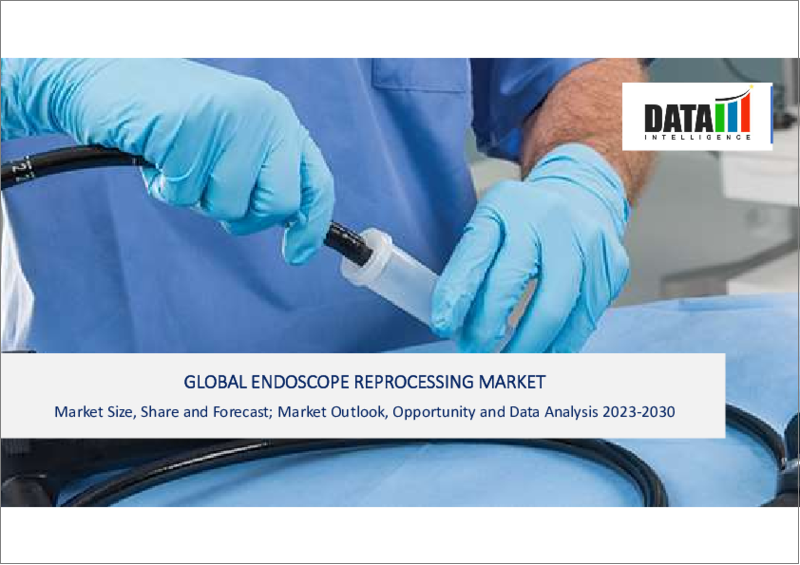|
|
市場調査レポート
商品コード
1319133
内視鏡リプロセスの世界市場-2023年~2030年Global Endoscope Reprocessing Market - 2023-2030 |
||||||
カスタマイズ可能
適宜更新あり
|
|||||||
| 内視鏡リプロセスの世界市場-2023年~2030年 |
|
出版日: 2023年07月31日
発行: DataM Intelligence
ページ情報: 英文 195 Pages
納期: 即日から翌営業日
|
- 全表示
- 概要
- 目次
市場概要
世界の内視鏡リプロセス市場は、2022年に23億米ドルに達し、2030年には45億米ドルに達すると予測されています(予測期間2023-2030年のCAGRは9.2%)。医療に対する意識の高まり、コネクティビティ機能の統合、データトラッキング、遠隔モニタリング機能などの技術の進歩が、内視鏡リプロセス市場動向の需要を押し上げています。
内視鏡リプロセスは、感染予防方法および医療手術中の患者の安全を確保するために重要です。 内視鏡リプロセスは、効果的な汚染除去を保証し、医療関連疾患のリスクを軽減するために重要です。 超音波洗浄機、滅菌器、洗浄消毒器、乾燥・保管キャビネット、内視鏡トラッキングシステム、その他のソリューションが市場に含まれています。
世界の内視鏡リプロセス市場の範囲は、高レベル消毒剤・テストストリップ、洗剤・ワイプ、自動内視鏡リプロッセー、内視鏡乾燥・保管・輸送システムを含む、製品タイプ別で構成されており、内視鏡リプロセス市場シェアの使用率が増加しています。
内視鏡リプロセスの世界市場は、医療関連感染(HAI)の有病率の上昇、内視鏡処置の増加、患者の安全性への関心の高まり、低侵襲手術への嗜好の高まり、老人人口の増加などの要因の結果として拡大しています。
市場力学
老年人口の増加が内視鏡リプロセス市場の成長を牽引すると予測
老年人口の増加は、内視鏡リプロセス産業を前進させると予測されます。高齢者人口の増加に伴い、内視鏡処置などの医療サービスに対する需要も増加します。老人患者は、内視鏡の使用を含む、より定期的な診察や診断処置を頻繁に必要とします。内視鏡リプロセスは、これらの処置の安全性と有効性を確保するために不可欠です。
例えば、世界保健機関(WHO)の2022年報告によると、2030年までに地球上の約6人に1人が60歳以上の高齢者となります。この期間内に、60歳以上の世界人口に占める割合は、2020年の10億人から14億人に増加すると予想されています。その結果、高齢者人口の増加が内視鏡リプロセスの需要増につながり、市場を前進させる。
低侵襲手術への嗜好の高まりが内視鏡リプロセス世界市場の主要促進要因
低侵襲手術は、伝統的な手術手技よりも大きな利点があるため、ますます人気が高まっています。これらの利点には、不快感が少ない、入院期間が短い、問題が少ない、傷跡が少ない、組織損傷が少ないなどがあります。低侵襲手術の人気の高まりは、患者、医療プロバイダー、業界全体に影響を与える様々な要因によってもたらされています。内視鏡リプロセスは、低侵襲手術を可能にする上で極めて重要です。内視鏡の消毒は手作業でも機械でも可能です。
腹腔鏡による低侵襲手術の増加は市場を牽引する大きな要因です。例えば、Cleveland Clinicの2022年の記事によると、毎年、世界中で1,300万件の腹腔鏡手術が行われています。この数字は今後5年間で1%上昇すると予想されています。低侵襲手術の必要性が高まるにつれ、効果的で信頼できる内視鏡リプロセスソリューションへの要求も高まっています。
有資格専門家の不足が市場の成長を妨げる
内視鏡的再処理装置を効果的にモニターする有資格の専門家の不足は、主要な商業的制限です。これらのシステムの適切なモニタリングとメンテナンスは、内視鏡の消毒と滅菌を成功させるために不可欠です。しかし、装置の複雑さと、その操作に必要な専門的知識が、資格のある専門家に対する需要を生み出しています。
このような技術者の不足は、システムの性能、安全規制の遵守、患者の安全性の保証の面で問題を引き起こします。この不足に対処し、技術者に適切なトレーニングとリソースを提供することは、この制約を克服し、内視鏡リプロセス事業の拡大を支援する上で重要な要素です。
COVID-19影響分析
COVID-19の流行は内視鏡リプロセス市場に大きな影響を及ぼし、感染予防と管理方法がより重視されるようになっています。個人用保護具の需要の増加やサプライチェーンの問題は、再処理機器や消耗品の入手可能性やコストに影響を与えました。内視鏡処置と患者数の変化、特に緊急でない手術の延期が、再処理サービスの需要に影響を与えています。
遠隔医療と遠隔モニタリングの使用は、斬新な再処理ソリューションへの需要を増加させています。医療施設は、洗浄の改善、従業員トレーニング、モニタリングなど、衛生とリプロセシングの実践を優先しています。
例えば、2021年に発表された国立医学図書館の論文によると、内視鏡の安全な再処理を保証するために、手袋、ガウン、フェイスシールド、その他の装備を含む特定の予防措置が推奨されると述べています。それは主に、近い将来の業界の成長のためにそのような措置の必要性を強調しています。全体として、COVID-19パンデミックは、内視鏡処置を通して患者の安全を保証するために、絶え間ない警戒と修正を必要としています。
ロシア・ウクライナ紛争の影響分析
現在進行中のロシアとウクライナの紛争は、内視鏡リプロセス部門に多大な影響を及ぼしています。侵攻とその結果起こった出来事はサプライチェーンに障害をもたらし、部品不足、物流の課題、コスト増をもたらしました。
これらの困難は、インフレ圧力と相まって、医療クライアントの財務状況に影響を及ぼしています。さらに、パンデミック(世界的大流行)の継続的な影響により、医療サービス(特に選択的手術)の回復が遅れています。このような環境において、医療の生産性を向上させることがますます重要になってきており、内視鏡リプロセス分野におけるスマートな製品とサービスは、このような需要に応えるのに役立ちます。
目次
第1章 調査手法と調査範囲
第2章 定義と概要
第3章 エグゼクティブサマリー
第4章 市場力学
- 影響要因
- 促進要因
- 老年人口の増加
- 低侵襲治療への嗜好の高まり
- 抑制要因
- 資格のある専門家の不足
- 機会
- 影響分析
- 促進要因
第5章 産業分析
- ポーターの5フォース分析
- サプライチェーン分析
- 価格分析
- 規制分析
第6章 COVID-19分析
第7章 製品別
- 高レベル消毒剤・テストストリップ
- 洗剤・ワイプ
- 自動内視鏡リプロセッサー
- 内視鏡乾燥・保管・輸送システム
- その他
第8章 エンドユーザー別
- 病院
- 外来手術センター
- その他
第9章 地域別
- 北米
- 米国
- カナダ
- メキシコ
- 欧州
- ドイツ
- 英国
- フランス
- スペイン
- イタリア
- その他欧州
- 南米
- ブラジル
- アルゼンチン
- その他南米
- アジア太平洋
- 中国
- インド
- 日本
- オーストラリア
- その他アジア太平洋地域
- 中東・アフリカ
第10章 競合情勢
- 競合シナリオ
- 市況/シェア分析
- M&A分析
第11章 企業プロファイル
- Cantel Medical
- 会社概要
- 製品ポートフォリオと説明
- 財務概要
- 主な発展
- Ecolab Inc
- STERIS plc.
- Olympus Corporation
- Getinge AB
- Belimed AG
- CONMED Corporation
- Laboratoires Anios
- SciCan Inc.
- HOYA Corporation
第12章 付録
Market Overview
The Global Endoscope Reprocessing Market reached US$ 2.3 billion in 2022 and is expected to reach US$ 4.5 billion by 2030 growing with a CAGR of 9.2% during the forecast period 2023-2030). The growing awareness of healthcare, advancement in technologies such as integration of connectivity features, data tracking, and remote monitoring capabilities are driving up demand for endoscope reprocessing market trends.
Endoscope reprocessing is critical in infection prevention methods and for ensuring patient safety during medical operations. Endoscope reprocessing is critical for guaranteeing effective contamination removal and lowering the risk of healthcare-associated illnesses. Ultrasonic washers, sterilizers, washer disinfectors, drying and storage cabinets, endoscope tracking systems, and other solutions are included in the market.
The global endoscope reprocessing market scope comprises components encompassing product types, high-level disinfectants and test strip, detergents and wipes, automated endoscope reprocessors, endoscope drying, storage, and transport systems which has increased usage of endoscope reprocessing market share.
The global market for endoscope reprocessing is expanding as a result of factors including rising prevalence of healthcare-associated infections (HAI's), increasing number of endoscopic procedures, increasing focus on patient safety, increasing preference for minimally invasive surgeries, and growing geriatric population.
Market Dynamics
Rising Geriatric Population is Estimated to Drive the Growth of the Endoscope Reprocessing Market
The growing geriatric population is projected to propel the endoscope reprocessing industry forwards. As the older population grows, so does the demand for healthcare services such as endoscopic procedures. Geriatric patients frequently require more regular medical examinations and diagnostic procedures including the use of endoscopes. Endoscope reprocessing is critical to ensuring the safety and effectiveness of these procedures.
For instance, according to World Health Organization (WHO) 2022 report, by 2030, about one out of every six people on the planet will be 60 or older. Within this time span, the share of the world population aged 60 and up is expected to increase from 1 billion in 2020 to 1.4 billion. As a result, the growing elderly population adds to an increased demand for endoscope reprocessing, propelling the market forwards.
Rising Preference toward Minimal Invasive Procedures is the Major Driver in the Global Endoscope Reprocessing Market
Minimally invasive operations are becoming increasingly popular due to their significant advantages over traditional surgical techniques. These advantages include less discomfort, shorter hospital stays, fewer problems, less scarring, and less tissue damage. The growing popularity of minimally invasive surgeries is being driven by a variety of factors affecting patients, healthcare providers, and the industry as a whole. Endoscopic reprocessing is critical in enabling minimally invasive operations. Endoscope disinfection can be done manually or using machines.
The rising laproscopic minimal invasive surgeries is major factor to drive the market. For instance, according to Cleveland Clinic organization 2022 article, every year, 13 million laparoscopic surgeries are performed worldwide. These figures are expected to rise by 1% during the following five years. As the need for minimally invasive surgeries grows, consequently rises the requirement for effective and dependable endoscopic reprocessing solutions.
Lack of Qualified Professional will Hamper the Growth of the Market
The lack of qualified professionals to effectively monitor endoscopic reprocessing equipment is a key commercial limitation. The appropriate monitoring and maintenance of these systems are critical to ensuring successful disinfection and sterilization of endoscopes. However, the complexity of the equipment and the specialized expertise necessary for its operation creates a demand for qualified specialists.
The shortage of such technicians causes issues in terms of system performance, compliance with safety regulations, and guaranteeing patient safety. Addressing this shortfall, as well as providing proper training and resources for technicians, are critical components in overcoming this constraint and supporting the expansion of the endoscopic reprocessing business.
COVID-19 Impact Analysis
The COVID-19 pandemic had a major effect on the endoscope reprocessing market, with a greater emphasis on infection prevention and control methods. Increased demand for personal protection equipment, as well as supply chain problems, have impacted the availability and cost of reprocessing equipment and supplies. Endoscopy procedures and patient volume change, especially the deferral of non-urgent operations, have influenced the demand for reprocessing services.
The use of telemedicine and remote monitoring has increased the demand for novel reprocessing solutions. Healthcare facilities have prioritized hygiene and reprocessing practices, such as improved cleaning, employee training, and monitoring.
For instance, according to National Library of Medicine article published in 2021, stated that to ensure the safe reprocessing of endoscopes, certain precautions, which include gloves, gowns, face shields, and other equipment, are advised. That mainly, emphasizes the need for such measures for the industry's growth in the near future. Overall, the COVID-19 pandemic has required constant vigilance and modification to guarantee patient safety throughout endoscopic procedures.
Russia-Ukraine War Impact Analysis
The ongoing conflict between Russia and Ukraine has had a considerable impact on the endoscope reprocessing sector. The invasion and resulting events have produced hurdles in the supply chain, resulting in component shortages, logistical challenges, and increased costs.
These difficulties, combined with inflationary pressures, have impacted the financial status of healthcare clients. Furthermore, the pandemic's continued impacts have slowed the recovery of healthcare services, notably elective surgeries. Improving healthcare productivity has become increasingly crucial in this environment, and smart products and services in the field of endoscope reprocessing can help to meet this demand.
Segment Analysis
The global endoscope reprocessing market is segmented based on product, end user and region.
Hospitals Segment Accounts for 41.1% of Market Share Owing to the Usage of Endoscopic Devices
Hospitals are important consumers of endoscopes, using them in a variety of diagnostic and therapeutic procedures such as gastrointestinal, urological, and pulmonary interventions. Because of the high volume of surgical procedures performed in hospitals, there is an elevated danger of cross-contamination and the spread of infections. To overcome this issue, hospitals are widely implementing sterilizers, automated endoscope reprocessors, and other advances in technology.
For instance, in April 2023, Children's Hospital Los Angeles (CHLA) became the first healthcare centre in California to use the EvoEndo Single-Use Endoscopy System for diagnostic unsedated TNE procedures of the Upper Gastrointestinal (GI) Tract. So to assure the safety and effectiveness of endoscopic treatments, they prioritize the use of efficient and dependable reprocessing methods. Endoscope cleaning, disinfection, and sterilization are handled by dedicated reprocessing departments or facilities equipped with specialized equipment and well-trained people.
Furthermore, hospitals exhibit a commitment to preventing cross-contamination and infections by striving to maintain strict reprocessing procedures and standards. The hospital segment's dominance in the endoscope reprocessing market can be ascribed to the large volume of endoscopic procedures conducted in hospitals, as well as their continuous commitment to patient safety and infection control. Thus, owing to the above factors the segment is expected to grow over the forecast period.
Geographical Analysis
North America Accounted for Approximately 39.3% of the Market Share Owing to the Increasing Collaborations
North America is likely to maintain its dominant position in the market due to increased investments and collaborations. The region's hostile commitment to encouraging breakthroughs and developments in endoscope reprocessing technology has garnered considerable investments from industrial players and academic organizations. Collaborations between healthcare providers, manufacturers, and regulatory authorities have also contributed to the market's rise.
For instance, in January 2023, AA Medical, a company dedicated to providing sustainable solutions for the new and resale medical device equipment sectors, announced a successful collaboration with Certified Endoscopy Products, a well-known medical device reprocessing company situated in Chicago. This collaboration seeks to gain a dominant market position by delivering high-quality reprocessing services for endoscopic equipment, as well as catering to the orthopedic and other surgical device sectors. Thus owing to the above factors the region is expected to dominate the market over the forecast period.
Competitive Landscape
The major global players in the endoscope reprocessing market include: Cantel Medical, Ecolab Inc, STERIS plc., Olympus Corporation, Getinge AB, Belimed AG , CONMED Corporation, Laboratoires Anios, SciCan Inc., HOYA Corporation, among others.
Why Purchase the Report?
- To visualize the global endoscope reprocessing market segmentation based on product, end user, and region, as well as understand key commercial assets and players.
- Identify commercial opportunities by analyzing trends and co-development.
- Excel data sheet with numerous data points of endoscope reprocessing market-level with all segments.
- PDF report consists of a comprehensive analysis after exhaustive qualitative interviews and an in-depth study.
- Product mapping available as excel consisting of key products of all the major players.
The global endoscope reprocessing market report would provide approximately 53 tables, 54 figures and 195 Pages.
Target Audience 2023
- Manufacturers/ Buyers
- Industry Investors/Investment Bankers
- Research Professionals
- Emerging Companies
Table of Contents
1. Methodology and Scope
- 1.1. Research Methodology
- 1.2. Research Objective and Scope of the Report
2. Definition and Overview
3. Executive Summary
- 3.1. Snippet by Product
- 3.2. Snippet by End User
- 3.3. Snippet by Region
4. Dynamics
- 4.1. Impacting Factors
- 4.1.1. Drivers
- 4.1.1.1. Rising Geriatric Population
- 4.1.1.2. Rising Preference toward Minimal Invasive Procedures
- 4.1.2. Restraints
- 4.1.2.1. Lack of Qualified Professional
- 4.1.3. Opportunity
- 4.1.4. Impact Analysis
- 4.1.1. Drivers
5. Industry Analysis
- 5.1. Porter's 5 Forces Analysis
- 5.2. Supply Chain Analysis
- 5.3. Pricing Analysis
- 5.4. Regulatory Analysis
6. COVID-19 Analysis
- 6.1. Analysis of COVID-19
- 6.1.1. Scenario Before COVID-19
- 6.1.2. Scenario During COVID-19
- 6.1.3. Scenario Post COVID-19
- 6.2. Pricing Dynamics Amid COVID-19
- 6.3. Demand-Supply Spectrum
- 6.4. Government Initiatives Related to the Market During Pandemic
- 6.5. Manufacturers Strategic Initiatives
- 6.6. Conclusion
7. By Product
- 7.1. Introduction
- 7.1.1. Market Size Analysis and Y-o-Y Growth Analysis (%), By Product
- 7.1.2. Market Attractiveness Index, By Product
- 7.2. High-Level Disinfectants and Test Strips*
- 7.2.1. Introduction
- 7.2.2. Market Size Analysis and Y-o-Y Growth Analysis (%)
- 7.3. Detergents and Wipes
- 7.4. Automated Endoscope Reprocessors
- 7.5. Endoscope Drying, Storage, and Transport Systems
- 7.6. Others
8. By End User
- 8.1. Introduction
- 8.1.1. Market Size Analysis and Y-o-Y Growth Analysis (%), By End User
- 8.1.2. Market Attractiveness Index, By End User
- 8.2. Hospitals*
- 8.2.1. Introduction
- 8.2.2. Market Size Analysis and Y-o-Y Growth Analysis (%)
- 8.3. Ambulatory Surgery Centers
- 8.4. Other
9. By Region
- 9.1. Introduction
- 9.1.1. Market Size Analysis and Y-o-Y Growth Analysis (%), By Region
- 9.1.2. Market Attractiveness Index, By Region
- 9.2. North America
- 9.2.1. Introduction
- 9.2.2. Key Region-Specific Dynamics
- 9.2.3. Market Size Analysis and Y-o-Y Growth Analysis (%), By Product
- 9.2.4. Market Size Analysis and Y-o-Y Growth Analysis (%), By End User
- 9.2.5. Market Size Analysis and Y-o-Y Growth Analysis (%), By Country
- 9.2.5.1. U.S.
- 9.2.5.2. Canada
- 9.2.5.3. Mexico
- 9.3. Europe
- 9.3.1. Introduction
- 9.3.2. Key Region-Specific Dynamics
- 9.3.3. Market Size Analysis and Y-o-Y Growth Analysis (%), By Product
- 9.3.4. Market Size Analysis and Y-o-Y Growth Analysis (%), By End User
- 9.3.5. Market Size Analysis and Y-o-Y Growth Analysis (%), By Country
- 9.3.5.1. Germany
- 9.3.5.2. U.K.
- 9.3.5.3. France
- 9.3.5.4. Spain
- 9.3.5.5. Italy
- 9.3.5.6. Rest of Europe
- 9.4. South America
- 9.4.1. Introduction
- 9.4.2. Key Region-Specific Dynamics
- 9.4.3. Market Size Analysis and Y-o-Y Growth Analysis (%), By Product
- 9.4.4. Market Size Analysis and Y-o-Y Growth Analysis (%), By End User
- 9.4.5. Market Size Analysis and Y-o-Y Growth Analysis (%), By Country
- 9.4.5.1. Brazil
- 9.4.5.2. Argentina
- 9.4.5.3. Rest of South America
- 9.5. Asia-Pacific
- 9.5.1. Introduction
- 9.5.2. Key Region-Specific Dynamics
- 9.5.3. Market Size Analysis and Y-o-Y Growth Analysis (%), By Product
- 9.5.4. Market Size Analysis and Y-o-Y Growth Analysis (%), By End User
- 9.5.5. Market Size Analysis and Y-o-Y Growth Analysis (%), By Country
- 9.5.5.1. China
- 9.5.5.2. India
- 9.5.5.3. Japan
- 9.5.5.4. Australia
- 9.5.5.5. Rest of Asia-Pacific
- 9.6. Middle East and Africa
- 9.6.1. Introduction
- 9.6.2. Key Region-Specific Dynamics
- 9.6.3. Market Size Analysis and Y-o-Y Growth Analysis (%), By Product
- 9.6.4. Market Size Analysis and Y-o-Y Growth Analysis (%), By End User
10. Competitive Landscape
- 10.1. Competitive Scenario
- 10.2. Market Positioning/Share Analysis
- 10.3. Mergers and Acquisitions Analysis
11. Company Profiles
- 11.1. Cantel Medical*
- 11.1.1. Company Overview
- 11.1.2. Product Portfolio and Description
- 11.1.3. Financial Overview
- 11.1.4. Key Developments
- 11.2. Ecolab Inc
- 11.3. STERIS plc.
- 11.4. Olympus Corporation
- 11.5. Getinge AB
- 11.6. Belimed AG
- 11.7. CONMED Corporation
- 11.8. Laboratoires Anios
- 11.9. SciCan Inc.
- 11.10. HOYA Corporation
LIST NOT EXHAUSTIVE
12. Appendix
- 12.1. About Us and Services
- 12.2. Contact Us






